Wastewater Treatment Technology for Sustainable Tourism: Sunny Beach, Ravda WWTP Case Study
Abstract
1. Introduction
2. Materials and Methods
2.1. Samplings
2.2. Analyzed Parameters and Methods
2.3. Data Analysis
3. Results
3.1. Water Quantity per Overnight
3.2. Hydrochemical and Technological Parameters
3.3. Microscopic Analysis
3.4. Microbiological Parameters
4. Discussion
- Expanding the technological scheme through the enhancement and better control of denitrification. This is planned and currently being implemented during the summer operating mode.
- Increasing the rate of microbial dephosphatation and detoxification through targeted management of the activity and quantity of the microbial segment in the activated sludge (AS) of the genera Pseudomonas and Acinetobacter, as well as regulating the F/M ratio by maintaining an appropriate concentration of organic matter and the ratio of biogenic elements, carbon–nitrogen–phosphorus, optimal for the respective components of the overall treatment process.
- Microscopic monitoring of the floccular structure of the activated sludge is suitable for tracking and controlling potential deformations resulting from inappropriate parameters of the treatment process.
- The integration of a plasma module for the elimination of toxic pollutants and pathogens at the outlet is possible, along with other tested innovative modules such as specialized biofilters with zeolite as a carrier [78].
- Long-term and comprehensive monitoring of the operation of WWTPs that treat water from seasonal tourism provides valuable information on the possibilities for maintaining sustainable water cycle functioning in regions where the main economic sector is mass tourism [79]
- Innovations and the sustainability of water treatment processes in tourist facilities with high economic impact would ensure conditions for the sustainable functioning of water cycles, linked to sustainable water and environmental management in regions with intensive tourism [80].
5. Conclusions
Author Contributions
Funding
Data Availability Statement
Acknowledgments
Conflicts of Interest
References
- Pasciucco, F.; Pecorini, I.; Iannelli, R. Centralization of wastewater treatment in a tourist area: A comparative LCA considering the impact of seasonal changes. Sci. Total Environ. 2023, 897, 165390. [Google Scholar] [CrossRef] [PubMed]
- Lichtmannegger, T.; Hell, M.; Wehner, M.; Ebner, C.; Bockreis, A. Seasonal tourism’s impact on wastewater composition: Evaluating the potential of alternating activated adsorption in primary treatment. Sci. Total Environ. 2024, 926, 171869. [Google Scholar] [CrossRef] [PubMed]
- Franco, A.A.; Iglesias-Arroyo, D.; Egea-Corbacho, Á.; Martín-García, A.P.; Quiroga, J.M.; Coello, M.D. Influence of tourism on microplastic contamination at wastewater treatment plants in the coastal municipality of Chiclana de la Frontera. Sci. Total Environ. 2023, 900, 165573. [Google Scholar] [CrossRef] [PubMed]
- Gössling, S.; Hall, M.C. Tourism and Global Environmental Change; Taylor & Francis: Abingdon, UK, 2006. [Google Scholar]
- Cissé, G. Transitioning to Clean Water and Sanitation; MDPI—Multidisciplinary Digital Publishing Institute: Basel, Switzerland, 2021; p. 102. [Google Scholar]
- Geng, Y.; Maimaituerxun, M.; Zhang, H. Coupling coordination of water governance and tourism: Measurement and prediction. Discret. Dyn. Nat. Soc. 2020, 2020, 3683918. [Google Scholar] [CrossRef]
- Gössling, S.; Peeters, P.; Hall, C.M.; Ceron, J.P.; Dubois, G.; Scott, D. Tourism and water use: Supply, demand, and security. An international review. Tour. Manag. 2012, 33, 1–15. [Google Scholar] [CrossRef]
- Zorpas, A.A.; Coumi, C.; Drtil, M.; Voukalli, I. Municipal sewage sludge characteristics and waste water treatment plant effectiveness under warm climate conditions. Desalination Water Treat. 2011, 36, 319–333. [Google Scholar] [CrossRef]
- Ranieri, F.; D’Onghia, G.; Uricchio, A.F.; Cristina, R.A.; Lopopolo, L.; Ranieri, E. Sustainable tourism in the Tremiti Islands (South Italy). Sci. Rep. 2024, 14, 19021. [Google Scholar] [CrossRef]
- Gattringer, H.; Claret, A.; Radtke, M.; Kisser, J.; Zraunig, A.; Rodriguez-Roda, I.; Buttiglieri, G. Novel vertical ecosystem for sustainable water treatment and reuse in tourist resorts. Int. J. Sustain. Dev. Plan. 2016, 11, 263–274. [Google Scholar] [CrossRef]
- Siwek, J.P.; Biernacki, W. Effect of tourism-generated wastewater on biogenic ions concentrations in stream water in Tatra National Park (Poland). J. Prot. Mt. Areas Res. Manag. 2016, 8, 43–52. [Google Scholar] [CrossRef][Green Version]
- Boller, M. Small wastewater treatment plants—A challenge to wastewater engineers. Water Sci. Technol. 1997, 35, 1–12. [Google Scholar] [CrossRef]
- Cullen, R.; Dakers, A.J.; McNicol, J.; Meyer-Hubbert, G.K.; Simmons, D.G.; Fairweather, J.R. Tourism, Water and Waste in Akaroa: Implications of Tourist Demand on Infrastructure; Lincoln University: Canterbury, New Zealand, 2003. [Google Scholar]
- Đurišić-Mladenović, N.; Živančev, J.; Antić, I.; Rakić, D.; Buljovčić, M.; Pajin, B.; Llorca, M.; Farre, M. Occurrence of contaminants of emerging concern in different water samples from the lower part of the Danube River Middle Basin—A review. Environ. Pollut. 2024, 363, 25128. [Google Scholar] [CrossRef] [PubMed]
- Cervantes-Cocom, G.; Chan-Ceh, C.G. Water management and environmental education as facilitators of sustainable tourism development in Valladolid, Yucatan. Tecnol. Cienc. Agua 2020, 11, 31–91. [Google Scholar] [CrossRef]
- Tomren, E. Development of a Wastewater Technology Selection Tool: An Assessment Method for Nutrient Management and Energy Efficiency in Remote Tourist Areas. Ph.D. Thesis, Murdoch University, Perth, Australia, 2008. [Google Scholar]
- Espigares, J.L.N.; Segura, J.A.M.; Torres, E.H. Water policy and tourism in Spain: A regional analysis. Rev. Port. Estud. Reg. 2009, 22, 47–61. [Google Scholar] [CrossRef]
- Yaw, F., Jr. Cleaner technologies for sustainable tourism: Caribbean case studies. J. Clean. Prod. 2005, 13, 117–134. [Google Scholar] [CrossRef]
- Di Nica, V.; Rizzi, C.; Finizio, A.; Ferraro, L.; Villa, S. Behavioural responses of juvenile Daphnia magna to two organophosphorus insecticides. J. Limnol. 2022, 81, 2015. [Google Scholar] [CrossRef]
- Zraunig, A.; Estelrich, M.; Gattringer, H.; Kisser, J.; Langergraber, G.; Radtke, M.; Rodriguez-Roda, I.; Buttiglieri, G. Long term decentralized greywater treatment for water reuse purposes in a tourist facility by vertical ecosystem. Ecol. Eng. 2019, 138, 138–147. [Google Scholar] [CrossRef]
- Pérez, D.M.G.; Martín, J.M.M.; Martínez, J.M.G.; Sáez-Fernández, F.J. An analysis of the cost of water supply linked to the tourism industry. An application to the case of the Island of Ibiza in Spain. Water 2020, 12, 2006. [Google Scholar] [CrossRef]
- Mycoo, M. Sustainable tourism using regulations, market mechanisms and green certification: A case study of Barbados. J. Sustain. Tour. 2006, 14, 489–511. [Google Scholar] [CrossRef]
- Moncheva, S.; Racheva, E.; Kamburska, L.; D’Hernoncourt, J. Environmental and management constraints on tourism in Varna Bay, Bulgarian Black Sea coast. Ecol. Soc. 2012, 17, 35. [Google Scholar] [CrossRef]
- Chave, P. The EU Water Framework Directive; IWA Publishing: London, UK, 2000. [Google Scholar]
- Reopanichkul, P.; Carter, R.W.; Worachananant, S.; Crossland, C.J. Wastewater discharge degrades coastal waters and reef communities in southern Thailand. Mar. Environ. Res. 2010, 69, 287–296. [Google Scholar] [CrossRef]
- Antakyalı, D.; Krampe, J.; Steinmetz, H. Practical application of wastewater reuse in tourist resorts. Water Sci. Technol. 2008, 57, 2051–2057. [Google Scholar] [CrossRef] [PubMed]
- Mill, G.A.; Theophilou, J.A. Effluent re-use in a tourist resort—Larnaca sewage treatment and irrigation project—Cyprus. Water Sci. Technol. 1995, 32, 115–124. [Google Scholar] [CrossRef]
- Luckert, A.; Aguado, D.; García-Bartual, R.; Lafita, C.; Montoya, T.; Frank, N. Odour mapping and air quality analysis of a wastewater treatment plant at a seaside tourist area. Environ. Monit. Assess. 2023, 195, 1013. [Google Scholar] [CrossRef] [PubMed]
- Erdogan, N.; Tosun, C. Environmental performance of tourism accommodations in the protected areas: Case of Goreme Historical National Park. Int. J. Hosp. Manag. 2009, 28, 406–414. [Google Scholar] [CrossRef]
- Calheiros, C.S.; Franco, A.R.; Bessa, V.S.; Rangel, A.O.; Castro, P.M. Microbial communities inhabiting a constructed wetland applied to tourism wastewater treatment. In Proceedings of the Microbiotec ‘11—Portuguese Society for Microbiology, Braga, Portugal, 1–3 December 2011. [Google Scholar]
- Fatta, D.; Arslan Alaton, I.; Gokcay, C.; Rusan, M.M.; Assobhei, O.; Mountadar, M.; Papadopoulos, A. Wastewater reuse: Problems and challenges in Cyprus, Turkey, Jordan and Morocco. Eur. Water 2005, 11, 63–69. [Google Scholar]
- Zorpas, A.A.; Voukkali, I.; Loizia, P. The impact of tourist sector in the waste management plans. Desalination Water Treat. 2015, 56, 1141–1149. [Google Scholar] [CrossRef]
- Raschke, N. Environmental impact assessment as a step to sustainable tourism development. WIT Trans. Ecol. Environ. 2024, 84, 303–313. [Google Scholar]
- Otterpohl, R.; Wendland, C.; Al-Baz, I. Efficient Management of Wastewater: Its Treatment and Reuse in Water-Scarce Countries; Springer: Berlin/Heidelberg, Germany, 2008. [Google Scholar]
- Staunstrup, J.K.; Hjalager, A.M.; Steffansen, R.N.; Sørensen, M.T. Water footprints and sewage management challenges in second home tourism. Environ. Plan. E Nat. Space 2023, 6, 113–131. [Google Scholar] [CrossRef]
- Smith, B.G.; Ley, D. Sustainable tourism and clean water project for two Guatemalan communities: A case study. Desalination 2009, 248, 225–232. [Google Scholar] [CrossRef]
- Kavanagh, L.J.; Keller, J. Engineered ecosystem for sustainable on-site wastewater treatment. Water Res. 2007, 41, 1823–1831. [Google Scholar] [CrossRef]
- Gaulke, L.S.; Weiyang, X.; Scanlon, A.; Henck, A.; Hinckley, T. Evaluation criteria for implementation of a sustainable sanitation and wastewater treatment system at Jiuzhaigou National Park, Sichuan Province, China. Environ. Manag. 2010, 45, 93–104. [Google Scholar] [CrossRef] [PubMed]
- Frone, S.M.; Frone, D.F. Sustainable tourism and water supply and sanitation development in Romania. J. Tour. Hosp. Manag. 2013, 1, 140–153. [Google Scholar]
- Mycoo, M. Sustainable Tourism, Climate Change and Sea Level Rise Adaptation Policies in Barbados. Nat. Resour. Forum 2014, 38, 47–57. [Google Scholar] [CrossRef]
- Farsari, I.; Prastacos, P. Sustainable Tourism Indicators: Pilot Estimation for the Municipality of Hersonissos. In Proceedings of the International Scientific Conference “Tourism on Islands and Specific Destinations”, University of the Aegean, Chios, Greece, 14–16 December 2000. [Google Scholar]
- Topalova, Y. Biological Control and Management of Water Treatment; SaySet-Eco: Sofia, Bulgaria, 2009; p. 315. [Google Scholar]
- Orhon, D.; Sekoulov, I.; Dulkadiroglu, H. Innovative technologies for wastewater treatment in coastal tourist areas. Water Sci. Technol. 2002, 46, 67–74. [Google Scholar] [CrossRef]
- Creo, C.; Fraboni, C. Awards for the sustainable management of coastal tourism destinations: The example of the Blue Flag program. J. Coast. Res. 2011, 61, 378–381. [Google Scholar] [CrossRef]
- Carić, H.; Mackelworth, P. Cruise tourism environmental impacts–The perspective from the Adriatic Sea. Ocean. Coast. Manag. 2014, 102, 350–363. [Google Scholar] [CrossRef]
- Keskin, F.; Demirak, A.; Özdemir, N.; Özkan, H.; Özkan, A.; Aslan, A. The Impact of COVID-19 on Water Consumption and Treatment Capacity in Tourism Area: Example of Bodrum. J. Int. Environ. Appl. Sci. 2022, 17, 156–164. [Google Scholar]
- UN and Partners Appeal for US$ 43.4 Million to Help Refugees from Ukraine in Bulgaria. 2023. Available online: https://www.unhcr.org/bg/16607-un-and-partners-appeal-for-us-43-4-million-to-help-refugees-from-ukraine-in-bulgaria.html (accessed on 16 November 2024).
- After One Year of the War in Ukraine, UNICEF Calls to Continue Support and Solidarity for Ukrainian Children in Bulgaria. 2023. Available online: https://www.unicef.org/bulgaria/en/press-releases/after-one-year-war-ukraine-unicef-calls-continue-support-and-solidarity-ukrainian (accessed on 16 November 2024).
- UNICEF Fact Sheet. Ukraine Refugee Response in Bulgaria. 2023. Available online: https://www.unicef.org/bulgaria/en/media/16326/file/UNICEF%20Bulgaria%20Factsheet%20September%202023.pdf (accessed on 16 November 2024).
- National Statistical Institute. Available online: https://infostat.nsi.bg/ (accessed on 8 October 2024).
- Valchev, D.; Ribarova, I.; Uzunov, B.; Stoyneva-Gärtner, M.; Lyubomirova, V. Reclamation potential of onsite wastewater post-treatment with microalgae: Chemical elements perspective. Processes 2023, 11, 1819. [Google Scholar] [CrossRef]
- Lyubomirova, V.; Mihaylova, V.; Djingova, R. Chemical characterization of Bulgarian bottled mineral waters. J. Food Compos. Anal. 2020, 93, 103595. [Google Scholar] [CrossRef]
- BDS EN 14702-1; Characterization of Sludges—Settling Properties. Part 1: Determination of Settleability. Determination of the Proportion of Sludge Volume and Sludge Volume Index. European Committee for Standardization: Brusseles, Belgium, 2006; p. 16.
- Rice, E.W.; Bridgewater, L.; American Public Health Association. Standard Methods for the Examination of Water and Wastewater; American Public Health Association: Washington, DC, USA; Volume 10.
- BDS EN ISO 5815-1:2019; Water Quality—Determination of Biochemical Oxygen Demand After n Days (BODn)—Part 1: Dilution and Seeding Method with Allylthiourea Addition. ISO: Geneva, Switzerland, 2019.
- BDS EN 25663:2000; Water Quality—Determination of Kjeldahl Nitrogen—Method After Mineralization with Selenium. ISO: Geneva, Switzerland, 2000.
- BDS EN ISO 6878:2005; Water Quality—Determination of Phosphorus—Ammonium Molybdate Spectrometric Method. ISO: Geneva, Switzerland, 2005.
- Kuznetzov, S.I.; Dubinina, G.A. Methods for Investigation of Waters Microorganisms; Academy of Sciences of the USSR: Moskow, Russia, 1989. [Google Scholar]
- Basak, S.; Shetty, P.H. Conventional Microbial Counting and Identification Techniques. In Techniques to Measure Food Safety and Quality; Khan, M.S., Shafiur Rahman, M., Eds.; Springer: Berlin/Heidelberg, Germany, 2021. [Google Scholar]
- Annual Report and Comparative Analysis of the State of the Water and Sewerage Sector in the Republic of Bulgaria for 2020. Available online: https://dker.bg/uploads/documents/vik/prot_215_21.pdf (accessed on 17 November 2024).
- Complex permit of Ravda WWTP issued by the Ministry of Environment and Water of the Republic of Bulgaria. Unpublished work.
- Colmenarejo, M.F.; Rubio, A.; Sanchez, E.; Vicente, J.; Garcia, M.G.; Borja, R. Evaluation of municipal wastewater treatment plants with different technologies at Las Rozas, Madrid (Spain). J. Environ. Manag. 2006, 81, 399–404. [Google Scholar] [CrossRef]
- Maciołek, P.; Szymański, K.; Janowska, B.; Włodarczyk-Makuła, M. Improving efficiency of nitrogen removal from municipal wastewater in modified A2O technological system–case study. Desalination Water Treat. 2021, 229, 116–133. [Google Scholar] [CrossRef]
- Bunce, J.T.; Ndam, E.; Ofiteru, I.D.; Moore, A.; Graham, D.W. A review of phosphorus removal technologies and their applicability to small-scale domestic wastewater treatment systems. Front. Environ. Sci. 2018, 6, 8. [Google Scholar] [CrossRef]
- Li, Y.; Bai, X.; Ding, R.; Lv, W.; Long, Y.; Wei, L.; Xiang, F.; Wang, R. Removal of phosphorus and ammonium from municipal wastewater treatment plant effluent by manganese ore in a simulated constructed wetland. Environ. Sci. Pollut. Res. 2021, 28, 41169–41180. [Google Scholar] [CrossRef] [PubMed]
- Regulation No H-4 of 14.09.2012 on the Characterisation of Surface Waters. Available online: https://legislation.apis.bg/doc/1003915/0 (accessed on 10 November 2024).
- Torfs, E.; Nopens, I.; Winkler, M.K.H.; Vanrolleghem, P.A.; Balemans, S.; Smets, I.Y. Settling Tests; IWA Publishing: London, UK, 2016. [Google Scholar]
- Dimkov, R.; Topalova, Y.; Schneider, I. Ecological Biotechnology. In Environmental Biotechnology; SscieSet Eco: Sofia, Bulgaria, 2017; p. 396. [Google Scholar]
- Wells, E.C.; Zarger, R.K.; Whiteford, L.M.; Mihelcic, J.R.; Koenig, E.S.; Cairns, M.R. The impacts of tourism development on perceptions and practices of sustainable wastewater management on the Placencia Peninsula, Belize. J. Clean. Prod. 2016, 111, 430–441. [Google Scholar] [CrossRef]
- Ibrahim, Y.; Yusof, Y. Towards sustainable environmental management through green tourism: Case study on Borneo rainforest lodge. Asian J. Tour. Res. 2017, 2, 123–143. [Google Scholar] [CrossRef]
- Gabarda Mallorquí, A.; Fraguell Sansbelló, R.M.; Pavón, D.; Ribas Palom, A. Tourist development and wastewater treatment in the Spanish Mediterranean coast: The Costa Brava case study. Int. J. Sustain. Dev. Plan. 2016, 11, 245–254. [Google Scholar] [CrossRef]
- Vo, V.; Tillett, R.L.; Papp, K.; Chang, C.L.; Harrington, A.; Moshi, M.; Oh, E.C.; Gerrity, D. Detection of the Omicron BA. 1 variant of SARS-CoV-2 in Wastewater from a Las Vegas Tourist area. JAMA Netw. Open 2023, 6, e230550. [Google Scholar] [CrossRef]
- Tsagarakis, K.P.; Mara, D.D.; Angelakis, A.N. Wastewater management in Greece: Experience and lessons for developing countries. Water Sci. Technol. 2001, 44, 163–172. [Google Scholar] [CrossRef]
- Sha, C.; Shen, S.; Zhang, J.; Zhou, C.; Lu, X.; Zhang, H. A Review of Strategies and Technologies for Sustainable Decentralized Wastewater Treatment. Water 2024, 16, 3003. [Google Scholar] [CrossRef]
- Frone, S.; Frone, D.F. Water supply and sanitation development as a requirement for sustainable tourism development in Romania. In Proceedings of the WSEAS Tourism and Economic Development, Drobeta Turnu Severin, Romania, 27–29 October 2011; pp. 464–469. [Google Scholar]
- Angelakis, A.N.; Bontoux, L. Wastewater reclamation and reuse in Eureau countries. Water Policy 2001, 3, 47–59. [Google Scholar] [CrossRef]
- Oarga-Mulec, A.; Jenssen, P.D.; Klemenčič, A.K.; Uršič, M.; Bulc, T.G. Zero-discharge solution for blackwater treatment at remote tourist facilities. J. Clean. Prod. 2017, 166, 798–805. [Google Scholar] [CrossRef]
- Vera-Puerto, I.; Valdés, H.; Correa, C.; Olave, J.; Pérez, V.; Arias, C.A. Variation of thе feeding/resting period in modified vertical treatment wetlands (depth, zeolite as medium) employed for treating rural domestic wastewater in tourist areas. Water Sci. Amp; Technol. 2023, 88, 1394–1403. [Google Scholar] [CrossRef] [PubMed]
- Pankow, N.; Krause, S.; Schaum, C. Resilience Adaptation Through Risk Analysis for Wastewater Treatment Plant Operators in the Context of the European Union Resilience Directive. Water 2024, 16, 3098. [Google Scholar] [CrossRef]
- Boragno, V.; Bruzzi, L.; Tarantini, M.; Verità, S. The role of EMAS for sustainable coastal tourism. In Proceedings of the 1st International Conference on the Management of Costal Recreational Resources–Beaches, Yacht Marinas and Coastal Ecotourism, Gozo, Malta, 25–27 October 2004; pp. 20–23. [Google Scholar]
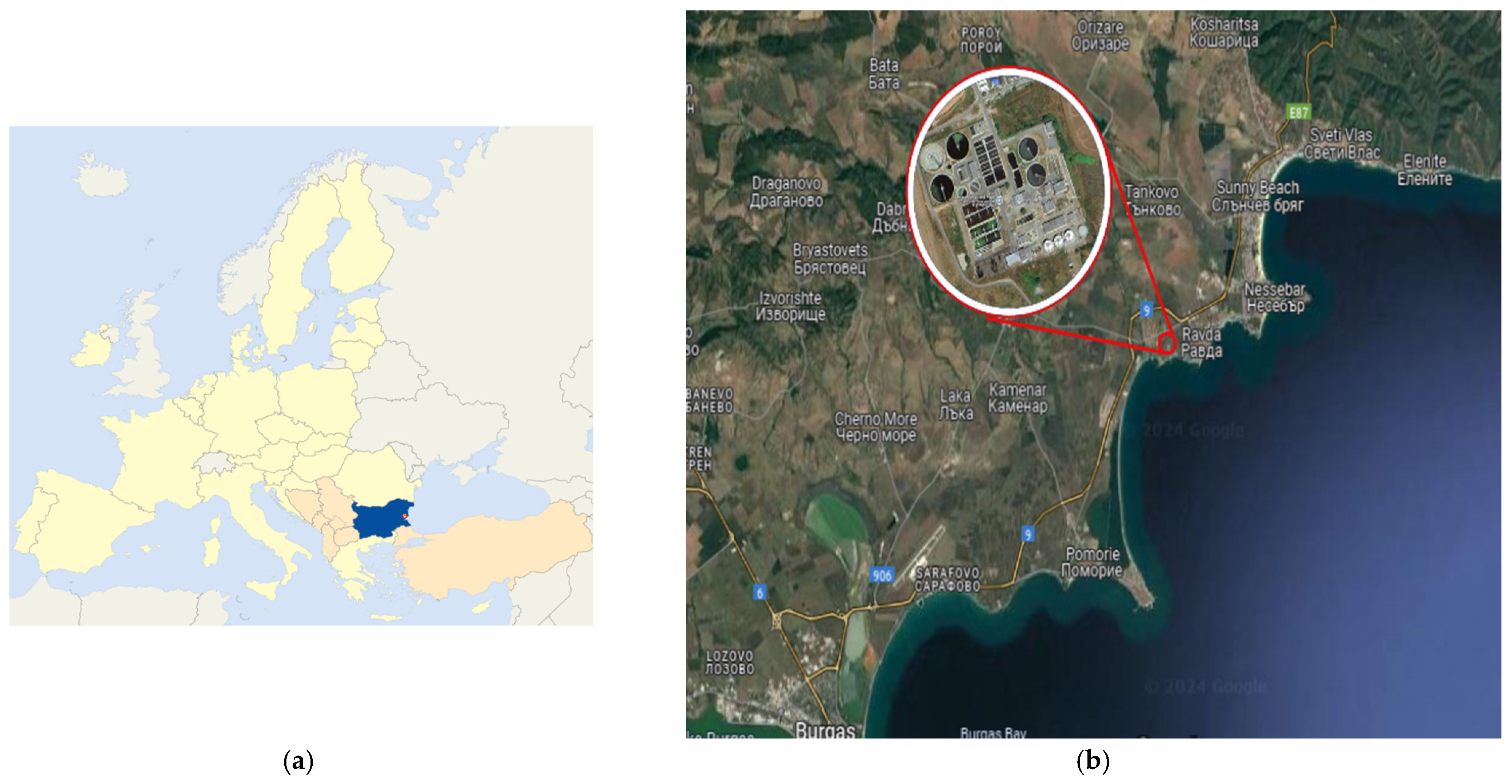

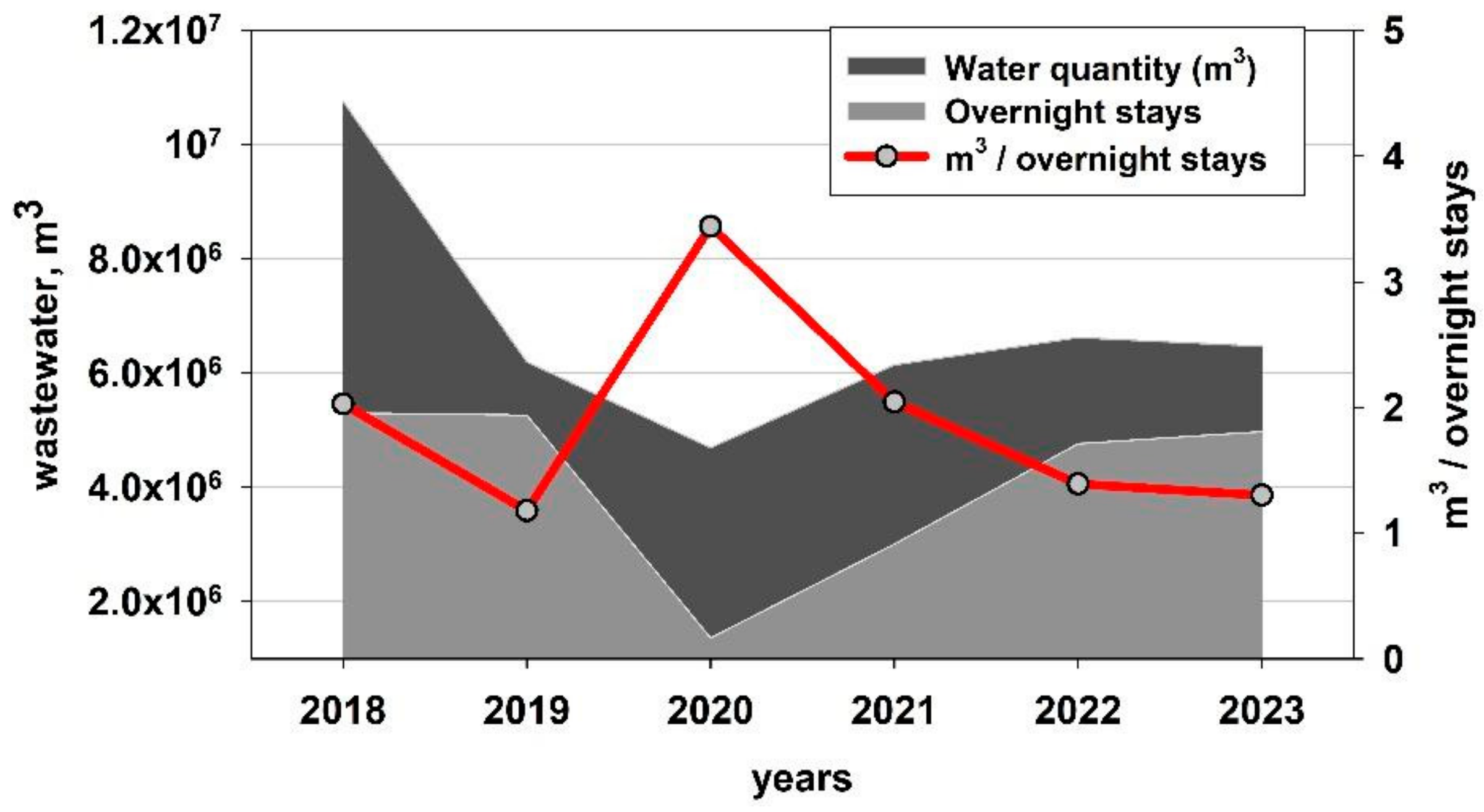



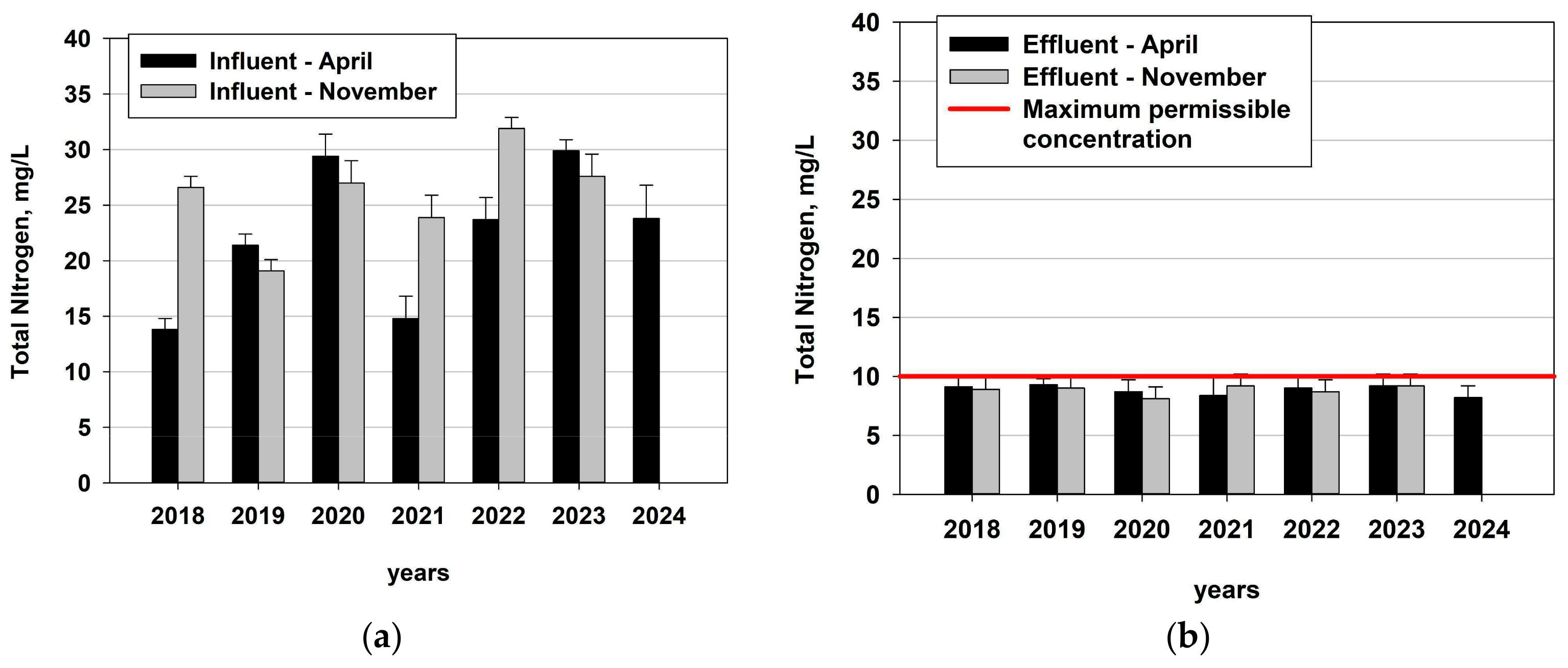
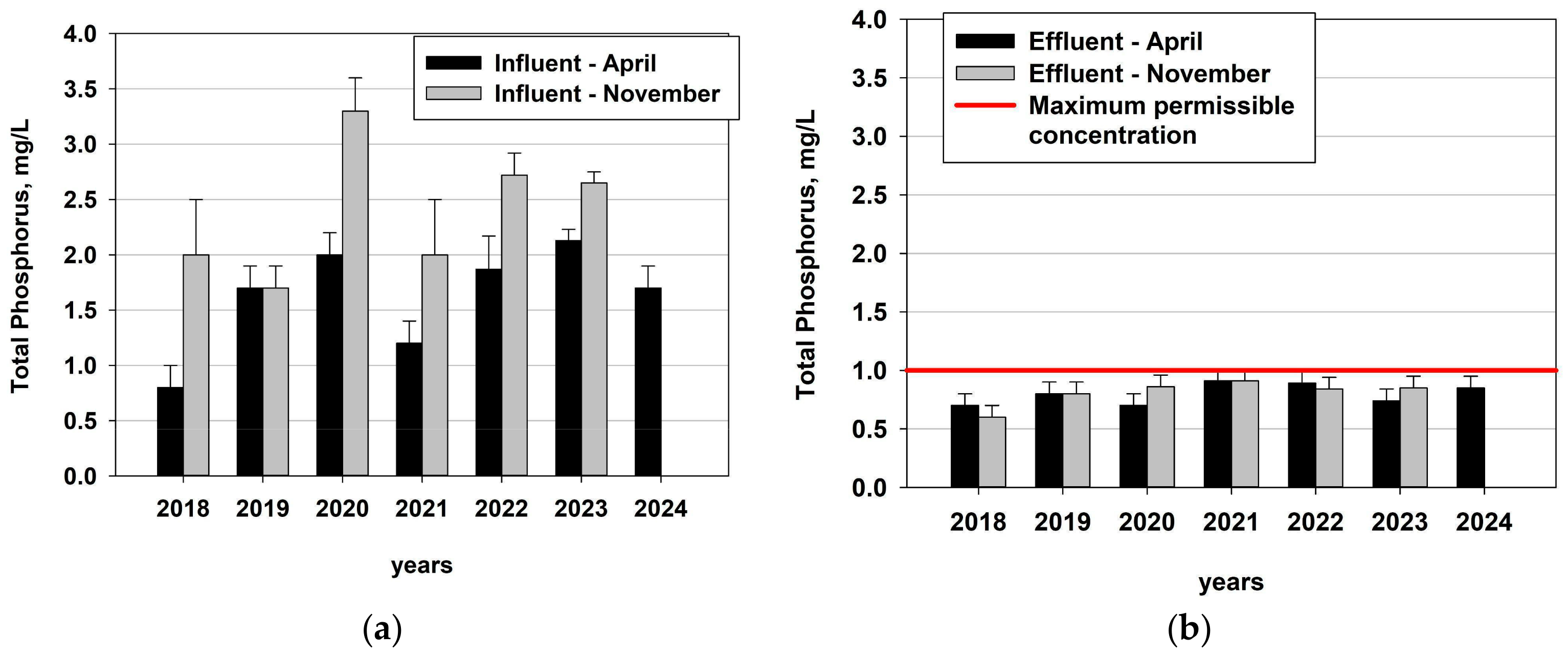


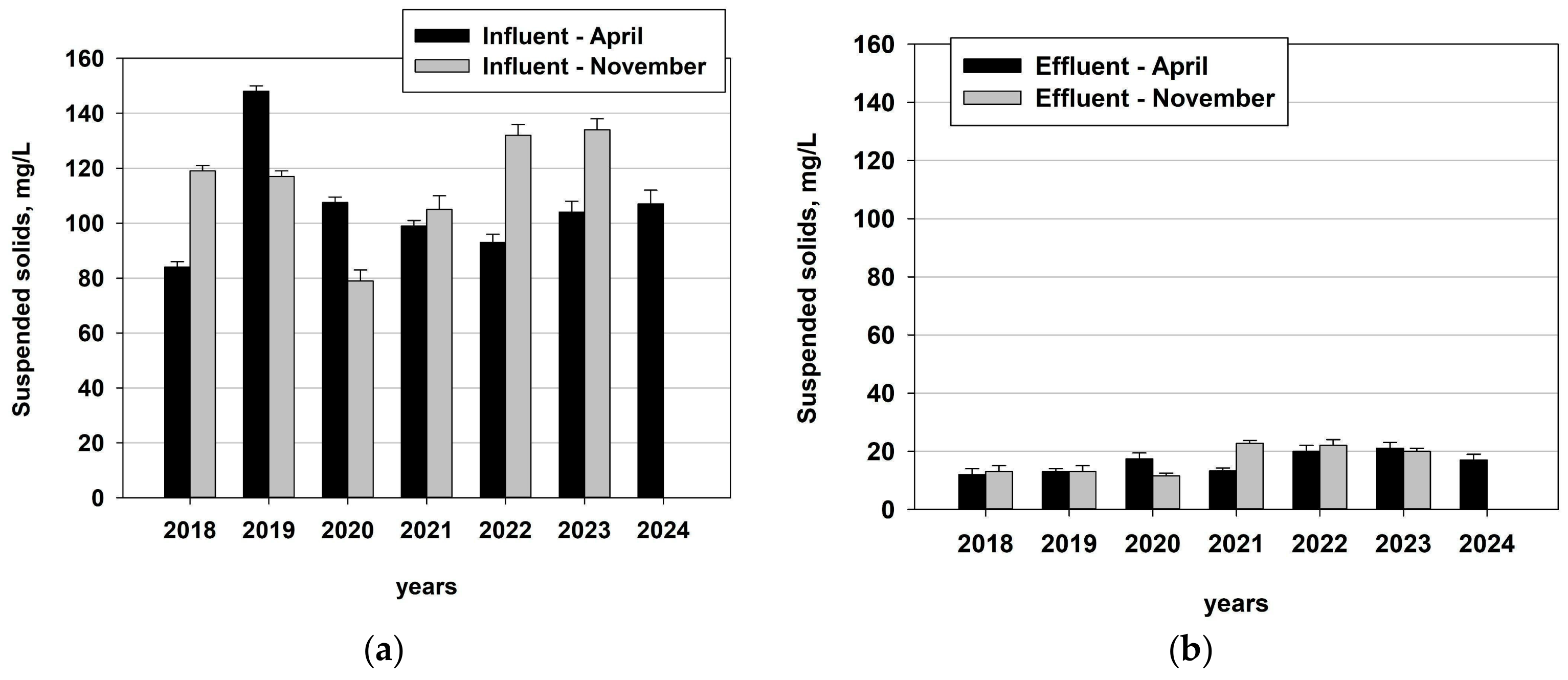
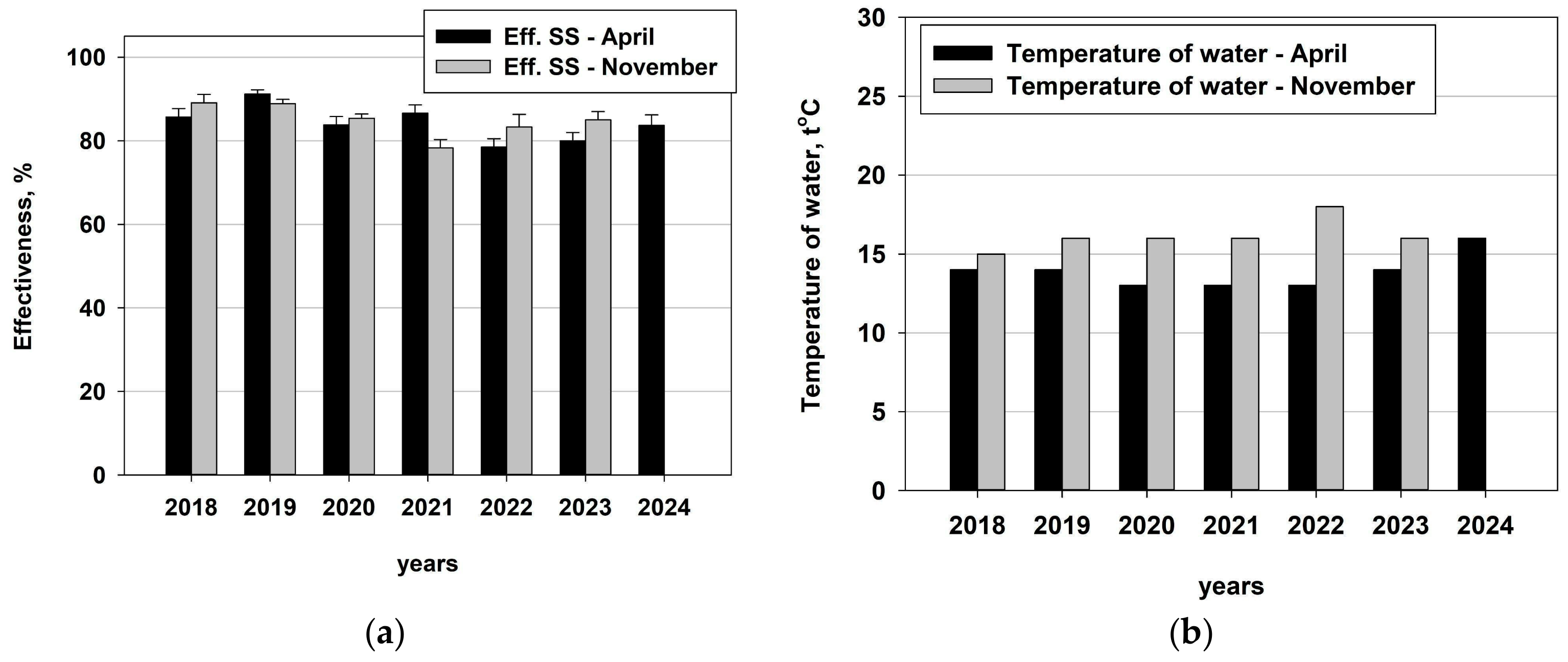

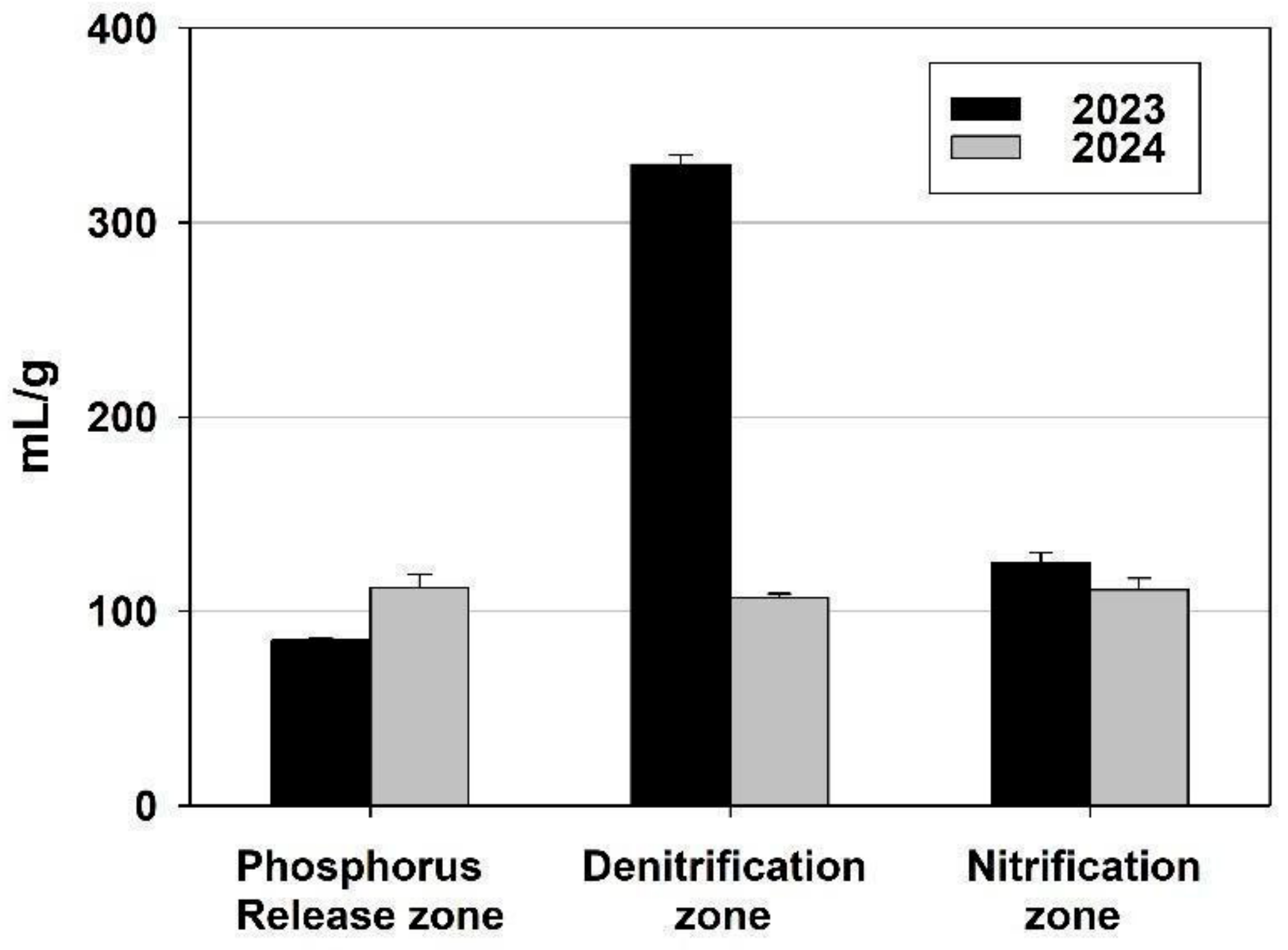



| Microbiological Parameter | Nutrient Medium | Manufacturer | Incubation |
|---|---|---|---|
| Aerobic heterotrophs (AeH) | Meat-peptone agar (MPA) | HiMedia | 24 h, 28 °C |
| Anaerobic heterotrophs (AnH) | Meat-peptone agar (MPA) | HiMedia | 24 h, 28 °C |
| Denitrification bacteria (Dn) | Giltai agar | HiMedia | 7 days, 28 °C |
| Pseudomonas sp. | GSP | HiMedia | 24 h, 28 °C |
| Acinetobacter sp. | Sellers | HiMedia | 24 h, 28 °C |
| El. | Influent 2023 | Effluent 2023 | Influent 2024 | Effluent 2024 | El. | Influent 2023 | Effluent 2023 | Influent 2024 | Effluent 2024 |
|---|---|---|---|---|---|---|---|---|---|
| Na | 295 ± 9 | 225 ± 7 | 200 ± 4 | 210 ± 5 | Li | 14.3 ± 0.4 | 12.7 ± 0.3 | 10.8 ± 0.3 | 10.1 ± 0.3 |
| K | 19.7 ± 0.6 | 18.1 ± 0.5 | 11.7 ± 0.4 | 10.6 ± 0.3 | Mn | 196 ± 6 | 86 ± 3 | 107 ± 3 | 1.7 ± 0.1 |
| Ca | 135 ± 4 | 105 ± 4 | 68 ± 2 | 64 ± 1 | Ni | 16.9 ± 0.5 | 14.7 ± 0.4 | 1.2 ± 0.1 | 1.3 ± 0.1 |
| Mg | 38 ± 1 | 33 ± 1 | 28.9 ± 0.9 | 28.3 ± 0.8 | Rb | 8.0 ± 0.3 | 7.9 ± 0.2 | 6.6 ± 0.2 | 7.1 ± 0.2 |
| Al | 142 ± 4 | 22.6 ± 0.7 | 19.0 ± 0.6 | 0.68 ± 0.02 | Sn | 0.15 ± 0.03 | 0.09 ± 0.01 | 0.18 ± 0.01 | 0.10 ± 0.01 |
| As | 6.7 ± 0.2 | 3.4 ± 0.1 | 7.2 ± 0.2 | 4.6 ± 0.2 | Se | 9.7 ± 0.5 | 5.0 ± 0.2 | 8.1 ± 0.4 | 4.4 ± 0.2 |
| Ba | 67 ± 2 | 7.3 ± 0.3 | 48 ± 2 | 23 ± 1 | Sr | 993 ± 40 | 730 ± 36 | 865 ± 39 | 634 ± 28 |
| Co | 1.32 ± 0.05 | 1.51 ± 0.04 | 0.69 ± 0.02 | 0.43 ± 0.02 | Ti | 383 ± 15 | 316 ± 10 | 339 ± 12 | 45 ± 2 |
| Cr | 2.1 ± 0.1 | 1.10 ± 0.04 | 19.1 ± 0.6 | 19.8 ± 0.5 | V | 5.7 ± 0.2 | 4.9 ± 0.2 | 5.3 ± 0.3 | 6.6 ± 0.3 |
| Cu | 8.6 ± 0.3 | 2.9 ± 0.1 | 2.1 ± 0.1 | 1.8 ± 0.1 | W | 3.1 ± 0.1 | 2.4 ± 0.1 | 10.0 ± 0.4 | 9.3 ± 0.4 |
| Fe | 880 ± 26 | 703 ± 21 | 717 ± 22 | 449 ± 13 | Zn | 18.1 ± 0.5 | 9.9 ± 0.3 | 10.1 ± 0.1 | 14.6 ± 0.3 |
| Microbiological Parameter | Month | Phosphorus Release Basin | Denitrification Basin | Nitrification Basin |
|---|---|---|---|---|
| Denitrification Bacteria | November 2023 | 368,217 ± 58 | 1,840,149 ± 19 | 1,498,674 ± 252 |
| April 2024 | 5833 ± 1389 | 7208 ± 974 | 2460 ± 437 | |
| Pseudomonas sp. | November 2023 | 46,802 ± 97 | 30,855 ± 4833 | 45,358 ± 928 |
| April 2024 | 18,264 ± 5069 | 17,857 ± 5519 | 17,103 ± 5913 | |
| Acinetobacter sp. | November 2023 | 464,147 ± 969 | 423,792 ± 26,022 | 814,324 ± 88,859 |
| April 2024 | 270,833 ± 4167 | 572,078 ± 60,390 | 16,468 ± 1984 |
Disclaimer/Publisher’s Note: The statements, opinions and data contained in all publications are solely those of the individual author(s) and contributor(s) and not of MDPI and/or the editor(s). MDPI and/or the editor(s) disclaim responsibility for any injury to people or property resulting from any ideas, methods, instructions or products referred to in the content. |
© 2024 by the authors. Licensee MDPI, Basel, Switzerland. This article is an open access article distributed under the terms and conditions of the Creative Commons Attribution (CC BY) license (https://creativecommons.org/licenses/by/4.0/).
Share and Cite
Bogdanova, M.; Yotinov, I.; Topalova, Y.; Lyubomirova, V. Wastewater Treatment Technology for Sustainable Tourism: Sunny Beach, Ravda WWTP Case Study. Water 2025, 17, 7. https://doi.org/10.3390/w17010007
Bogdanova M, Yotinov I, Topalova Y, Lyubomirova V. Wastewater Treatment Technology for Sustainable Tourism: Sunny Beach, Ravda WWTP Case Study. Water. 2025; 17(1):7. https://doi.org/10.3390/w17010007
Chicago/Turabian StyleBogdanova, Magdalena, Ivaylo Yotinov, Yana Topalova, and Valentina Lyubomirova. 2025. "Wastewater Treatment Technology for Sustainable Tourism: Sunny Beach, Ravda WWTP Case Study" Water 17, no. 1: 7. https://doi.org/10.3390/w17010007
APA StyleBogdanova, M., Yotinov, I., Topalova, Y., & Lyubomirova, V. (2025). Wastewater Treatment Technology for Sustainable Tourism: Sunny Beach, Ravda WWTP Case Study. Water, 17(1), 7. https://doi.org/10.3390/w17010007





